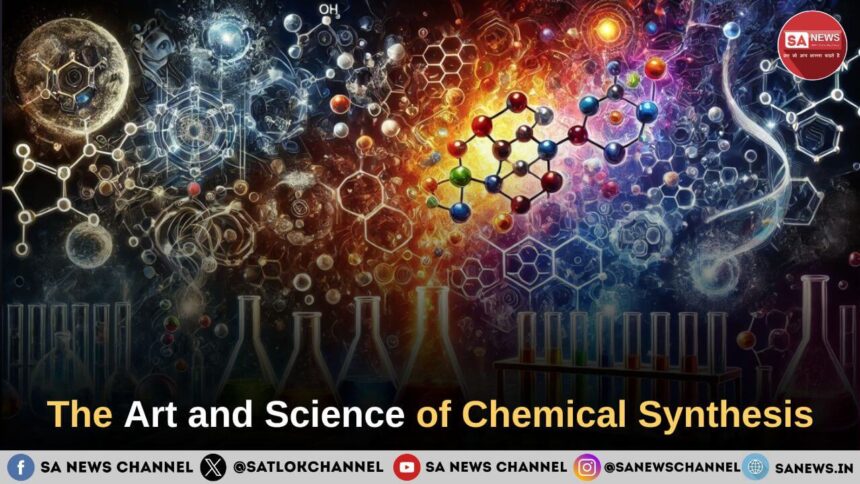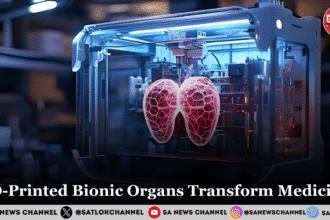Chemical synthesis refers to the method by which chemists merge basic substances to form intricate molecules. This discipline serves as a fundamental cornerstone of contemporary chemistry, significantly contributing to the advancement of novel materials, medications, and industrial methodologies.
It encompasses a combination of innovation and accuracy, integrating theoretical understanding with practical skills to address urgent issues across multiple fields. In this thorough examination, we will investigate the principles, methodologies, applications, obstacles, and prospective developments in chemical synthesis.
Introduction on Chemical Synthesis
Chemical synthesis, the process of creating complex molecules from simpler components, has its roots in the ancient practice of alchemy. Early practitioners of chemistry, often lacking a structured methodology, aimed to convert basic substances into precious materials such as gold or life-enhancing elixirs. Over the centuries, this enigmatic practice has transformed into a highly refined and systematic discipline that is essential to a variety of industries.
In contemporary times, chemical synthesis serves as the foundation for breakthroughs in pharmaceuticals, materials science, agriculture, and energy, expanding the limits of chemical possibilities. The capability to create new compounds has facilitated the invention of life-saving drugs, innovative materials, and processes that propel technological progress.
Fundamentals of Chemical Synthesis
Basic Principles and Concepts
Chemical synthesis fundamentally entails the creation and disruption of chemical bonds to form new molecules. This process is regulated by the principles of chemical reactivity, wherein reactants are transformed into products. The capacity to anticipate and control these transformations relies on a comprehensive understanding of molecular structures, electronic configurations, and reaction mechanisms—the sequential pathways through which reactions occur. Proficiency in these principles enables chemists to devise and implement effective synthetic strategies.
Types of Chemical Reactions Involved
Chemical synthesis employs a variety of reactions, each suited to specific molecular transformations:
- Addition Reactions: Two or more molecules combine to form a larger molecule, often used in polymer synthesis and hydrocarbon modifications.
- Substitution Reactions: An atom or group of atoms in a molecule is replaced by another atom or group, crucial in creating functionalized organic compounds.
- Elimination Reactions: Elements are removed from a molecule, leading to the formation of double or triple bonds, essential for creating unsaturated hydrocarbons.
- Condensation Reactions: Two molecules combine with the loss of a small molecule, such as water, enabling the synthesis of larger biomolecules and polymers.
Role of Catalysts
Catalysts are indispensable in chemical synthesis, as they lower the activation energy of reactions, increasing their rate without being consumed. Their role extends to enhancing selectivity and yield while reducing energy requirements. Common catalysts include:
- Enzymes: Biological catalysts that offer unparalleled specificity and operate under mild conditions.
- Metal Catalysts: Transition metals like palladium and platinum facilitate reactions like hydrogenation and cross-coupling.
- Organocatalysts: Organic molecules that catalyze reactions through non-covalent interactions or covalent intermediates.
Techniques and Methods
Classical Methods
Classical synthetic methods form the foundation of modern chemistry. Key examples include:
- Grignard Reactions: These involve the addition of Grignard reagents (organomagnesium compounds) to carbonyl compounds to form alcohols, a cornerstone in organic synthesis.
- Friedel-Crafts Alkylation and Acylation: These reactions introduce alkyl or acyl groups into aromatic rings, enabling the synthesis of numerous aromatic compounds used in dyes, plastics, and pharmaceuticals.
Modern Techniques
Technological advancements have brought forth innovative synthetic methods, including:
- Click Chemistry: A modular approach using reliable and selective reactions to assemble molecules rapidly and efficiently. This technique is widely used in drug development and biomaterials.
- Green Chemistry: Focuses on designing environmentally friendly processes that minimize hazardous substances and reduce waste, aligning chemistry with sustainability goals.
Advances in Synthetic Methods
Recent breakthroughs have revolutionized chemical synthesis:
- Automation: Robotic systems perform repetitive synthetic tasks with high precision, increasing efficiency and reproducibility. These systems are invaluable in high-throughput screening and combinatorial chemistry.
- Flow Chemistry: Reactions conducted in continuous flowing streams offer better control over reaction conditions, improved safety, and scalability, making them ideal for industrial applications.
- Microwave-Assisted Synthesis: This technique uses microwave radiation to accelerate reactions, often reducing reaction times from hours to minutes.
Applications in Industry
Pharmaceutical Synthesis
Chemical synthesis is the cornerstone of drug discovery and development. It enables the creation of novel compounds targeting specific diseases, leading to medications that improve patient outcomes and enhance quality of life. From antibiotics and antivirals to cancer therapies, synthetic chemistry drives innovation in healthcare. Moreover, advancements in asymmetric synthesis have allowed the production of enantiomerically pure drugs, increasing efficacy and reducing side effects.
Agrochemical Synthesis
In agriculture, chemical synthesis is vital for creating fertilizers, pesticides, and herbicides that boost crop yields and protect plants from pests and diseases. These innovations ensure food security for a growing global population while addressing challenges like climate change and resource scarcity. Research into biodegradable agrochemicals and precision-targeted formulations further exemplifies the role of synthesis in sustainable agriculture.
■ Also Read: Biological Classification: Understanding the Diversity of Life
Material Science and Nanotechnology
Material science relies heavily on chemical synthesis to develop advanced polymers, ceramics, and nanomaterials with unique properties. These materials find applications in electronics, renewable energy, healthcare, and environmental remediation. For instance, nanomaterials synthesized through chemical processes are used in drug delivery systems, sensors, and energy storage devices, demonstrating the transformative potential of synthesis in modern technology.
Challenges and Future Directions
Current Limitations and Obstacles
- Complexity of Reactions: Designing efficient synthetic routes for intricate molecules, especially natural products, is a complex task. Achieving the desired selectivity and yield while minimizing side reactions demands a profound understanding of reaction mechanisms and meticulous planning.
- Environmental Impact: Traditional methods often use hazardous reagents, solvents, and energy-intensive processes, contributing to pollution and waste. Moving towards greener practices is crucial for reducing the ecological footprint of chemical synthesis.
- Scalability: Scaling up reactions from laboratory to industrial scale presents significant challenges. Reactions that work well on a small scale can encounter issues like reduced yields and altered reaction rates when scaled up. Ensuring efficiency and safety at larger scales requires careful optimization.
Emerging Trends and Innovations
Chemical synthesis is on the cusp of transformation, driven by innovative trends that promise more efficient and sustainable processes. Here are some of the most exciting developments:
- Biocatalysis: Leveraging enzymes and microorganisms to catalyze reactions offers greener and more selective pathways, especially for creating complex molecules. Enzymes operate under mild conditions, reducing the need for hazardous reagents and minimizing waste.
- Artificial Intelligence (AI): AI is revolutionizing chemical synthesis by predicting reaction outcomes, optimizing synthetic routes, and accelerating discovery. Machine learning models analyze vast datasets to identify the most promising synthetic pathways, enhancing efficiency and reducing trial-and-error.
- Sustainable Synthesis: Emphasizing the use of renewable feedstocks, energy-efficient processes, and waste minimization aligns chemical synthesis with global sustainability goals. This approach reduces dependence on fossil resources and promotes environmentally friendly practices.
- Photoredox and Electrochemical Methods: These techniques use light or electricity to drive reactions, offering novel approaches to bond formation and functionalization. Photoredox catalysis, for instance, utilizes light-absorbing catalysts to enable unique transformations, while electrochemistry provides precise control over redox reactions.
These emerging trends and innovations are paving the way for a future where chemical synthesis is not only more efficient and versatile but also aligned with sustainability principles. As these technologies continue to evolve, they hold the potential to revolutionize how chemists design and produce new molecules, making significant impacts across various industries..
The Future of Chemical Synthesis
The integration of synthetic chemistry with biology, materials science, and computational tools is opening new horizons. Interdisciplinary approaches are enabling the design of multifunctional materials, bio-inspired molecules, and innovative energy solutions. As society moves toward a greener and more sustainable future, the quest for efficient, scalable, and eco-friendly synthetic methods will remain at the forefront of scientific progress, ensuring that chemical synthesis continues to be a dynamic and impactful field in the 21st century.
Just as chemical synthesis transforms simple substances into complex compounds, Sant Rampal Ji’s teachings guide individuals on a journey of spiritual enlightenment. Sant Rampal Ji’s teachings emphasize a path to spiritual enlightenment, guiding individuals towards inner peace and self-realization.
He encourages followers to understand their true nature and connect with their inner divinity through introspection and meditation. By focusing on spiritual goals and reducing attachment to material desires, one can achieve a higher state of consciousness and true contentment.
Sant Rampal Ji also underscores the importance of compassion and selfless service, advocating for acts of kindness and generosity as expressions of spiritual growth. He promotes living a life of virtue and integrity, adhering to moral principles such as honesty, humility, and non-violence.
This not only fosters personal spiritual development but also contributes to a harmonious and just society. In essence, Sant Rampal Ji’s teachings offer a transformative journey towards truth, harmony, and higher consciousness, guiding followers to a more fulfilling and enlightened life.









